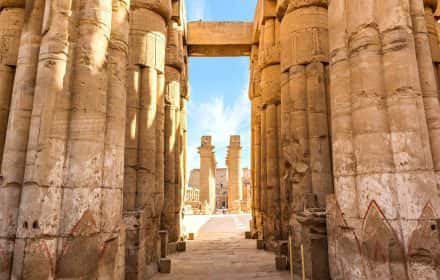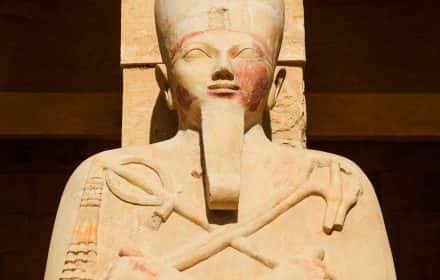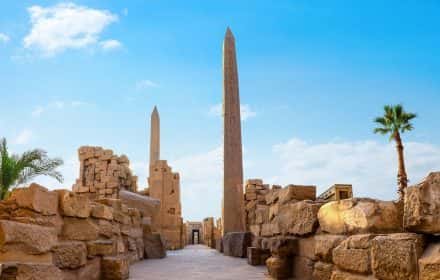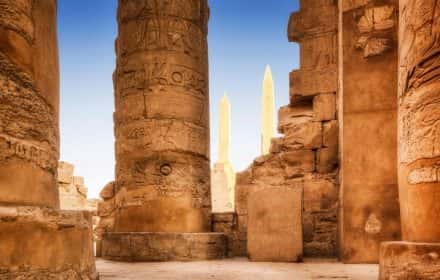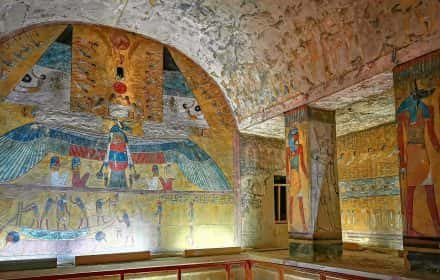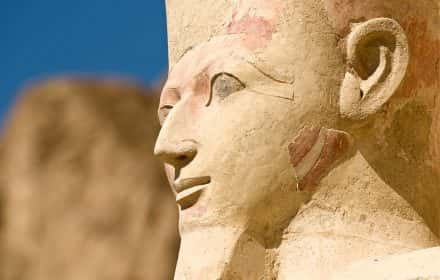This site uses affiliate links, meaning that if you make a purchase through our links, we may earn an affiliate commission.
Standing tall amidst the Egyptian desert, the Colossi of Memnon have captivated the imaginations of travelers, scholars, and adventurers for centuries.
These colossal statues, each carved from a single block of stone, have withstood the test of time, bearing witness to the rise and fall of civilizations, and embodying the enigmatic allure of ancient Egypt.
In this blog post, we embark on a journey to unravel the stories, myths, and mysteries that shroud these awe-inspiring monuments. From their historical significance to the legends that surround them, the Colossi of Memnon continue to inspire wonder and curiosity, inviting us to delve into the depths of their past and contemplate the enduring legacy of human creativity and engineering prowess.
Join us as we explore the secrets concealed within the stone giants that have stood sentinel over the Nile for millennia.
The Colossi of Memnon
- 1. Singing Statue Phenomenon: Enchanting Melody Mysteries
- 2. Monolithic Marvels: Extraordinary Colossi of Memnon Engineering
- 3. Guardians of Pharaoh's Legacy: Ancient Colossi of Memnon Significance
- 4. Architectural Symbolism: Colossi of Memnon Stone Messages
- 5. Legacy of Amenhotep III: Vision in Stone
- 6. Ancient Luxor's Cultural Hub: Heart of Civilization
- 7. Preserving Colossi of Memnon: Timeless Legacy Safeguarded
Singing Statue Phenomenon: Enchanting Melody Mysteries
One of the most captivating tales that have woven themselves into the narrative of the Colossi of Memnon is the story of the “singing” statue.
This remarkable phenomenon, often shrouded in mystery and speculation, has both intrigued and mystified observers for centuries.
- The Mythical Melodies
According to ancient accounts, the “singing” statue was said to emit a haunting, musical sound at the break of dawn.
As the first rays of sunlight kissed the colossal stone surface, an ethereal melody was said to emanate from within the statue itself, captivating those who were fortunate enough to witness it.
The phenomenon was first documented by Strabo, a Greek historian, during his visit to Egypt around 20 BCE.
- Theories and Explanations
Numerous theories have emerged over the years, each attempting to explain the enigmatic “singing” statue phenomenon.
One prominent hypothesis revolves around temperature fluctuations.
The statues’ immense size and solid quartzite composition meant they retained heat differently from their surroundings. As the statues absorbed the morning sunlight, their temperature increased, causing the stone to expand and contract.
This movement, it is believed, could have created internal stress, causing the stone to emit audible vibrations that resonated as a haunting sound.
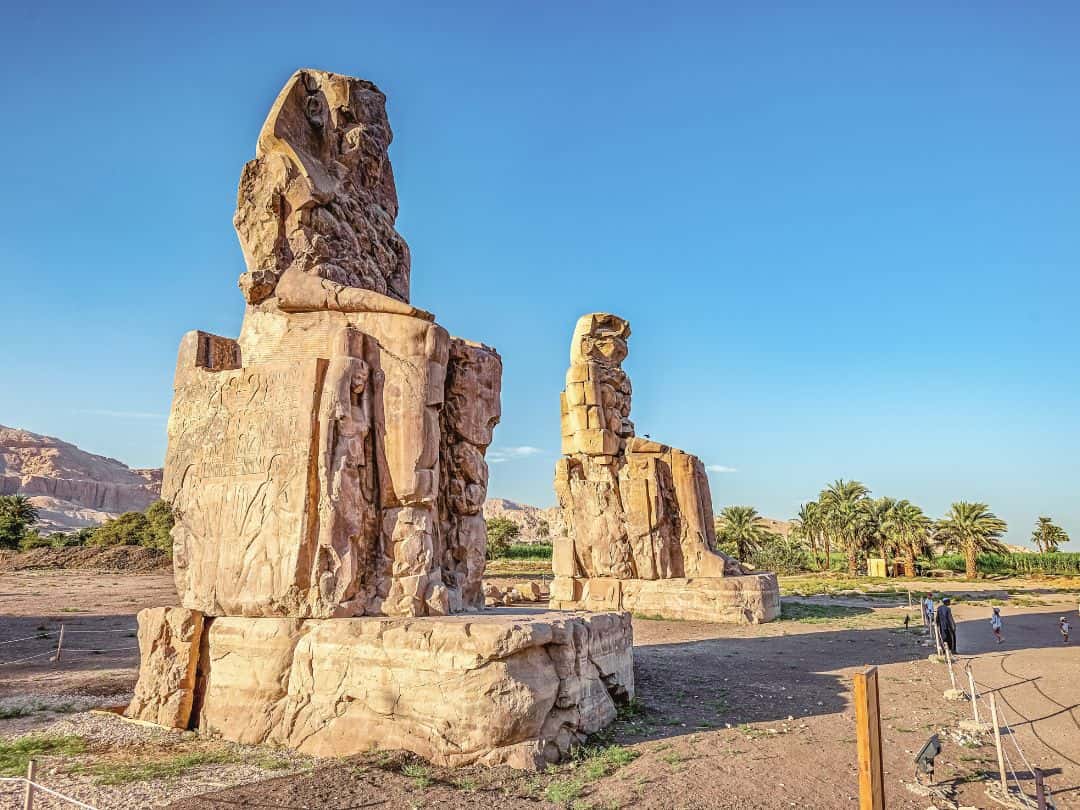
The Colossi of Memnon
- Seismic Activity’s Role
Another theory posits that seismic activity played a role in the phenomenon. The region around the Colossi of Memnon is prone to earthquakes due to its geological activity.
The theory suggests that when these seismic events occurred, even minor vibrations could have caused the cracks within the statues to shift slightly, resulting in the generation of audible sounds.
- Ancient Interpretations
In the context of ancient Egyptian beliefs, the “singing” statue took on a spiritual significance.
Egyptians associated such phenomena with communication from the divine or the presence of deities.
The idea that the statues themselves could transmit messages from the gods captured the imagination of the populace, elevating the Colossi beyond their roles as mere architectural marvels.
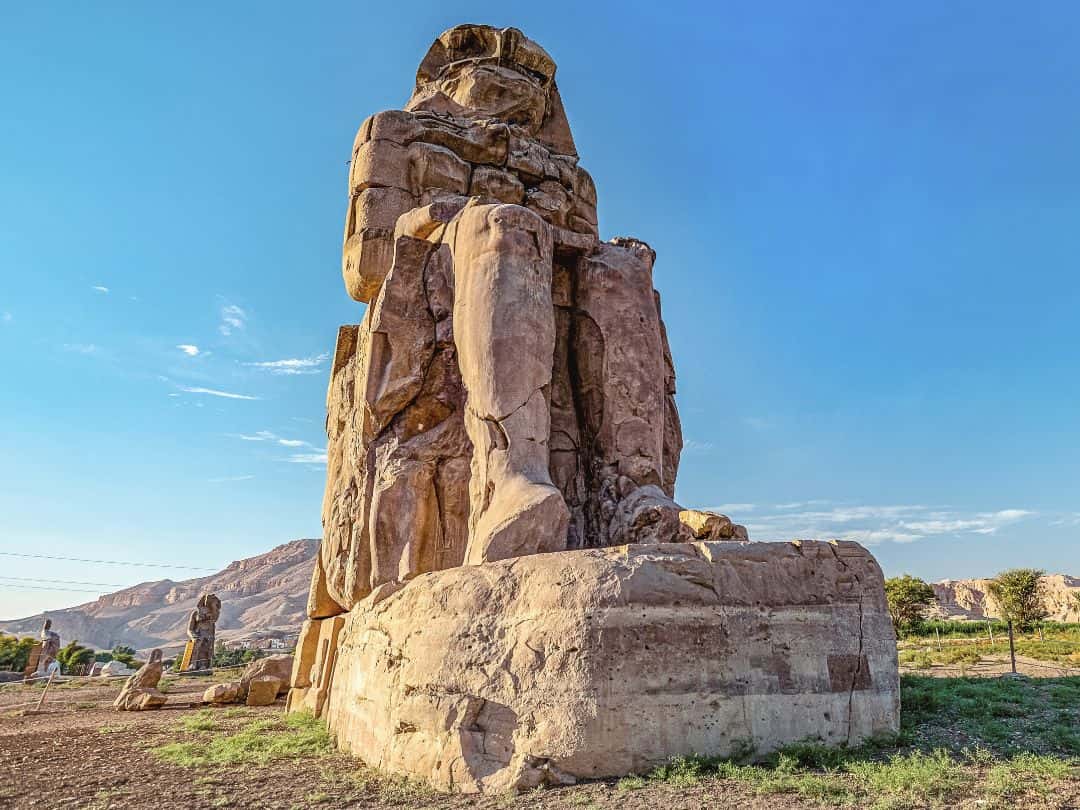
The Colossi of Memnon
- The Impact on Ancient Minds
The allure of the “singing” statue extended beyond its auditory intrigue. The tales of these melodic emanations were like whispers from the past, a bridge connecting the living to the pharaohs of old.
Pilgrims and travelers would journey to the site with hopes of experiencing this phenomenon for themselves, often interpreting the sounds as omens or blessings from the gods.
- Silenced by Time
Tragically, the “singing” statue’s song fell silent in 27 BCE when an earthquake damaged the statue, ending the phenomenon that had captivated the ancient world for centuries.
While the scientific explanations may have clarified the origin of the sounds, the impact of the legend persists, a testament to humanity’s timeless fascination with the intersection of the mystical and the natural.
The “singing” Colossi of Memnon stands as a perfect example of how the ancient world’s mysteries continue to intrigue and inspire us today.
The stories of these statues remind us that even in the realm of the unknown, there is beauty, wonder, and a deep connection to the past.
Monolithic Marvels: Extraordinary Colossi of Memnon Engineering
The Colossi of Memnon, standing as silent giants on the banks of the Nile, are not only artistic masterpieces but also engineering marvels that showcase the advanced craftsmanship of ancient Egypt.
Carved from single massive blocks of quartzite sandstone, each weighing an astonishing 720 tons, the creation of these monolithic statues remains a testament to the ingenuity of a civilization that harnessed its resources and knowledge to achieve the seemingly impossible.
- Selecting the Stone
The journey to create the Colossi began deep within the quarries of Gebel el-Silsila, where expert stonecutters meticulously selected the raw material for their colossal undertaking.
Quartzite, a dense and durable stone, was chosen for its ability to withstand the ravages of time and the elements.
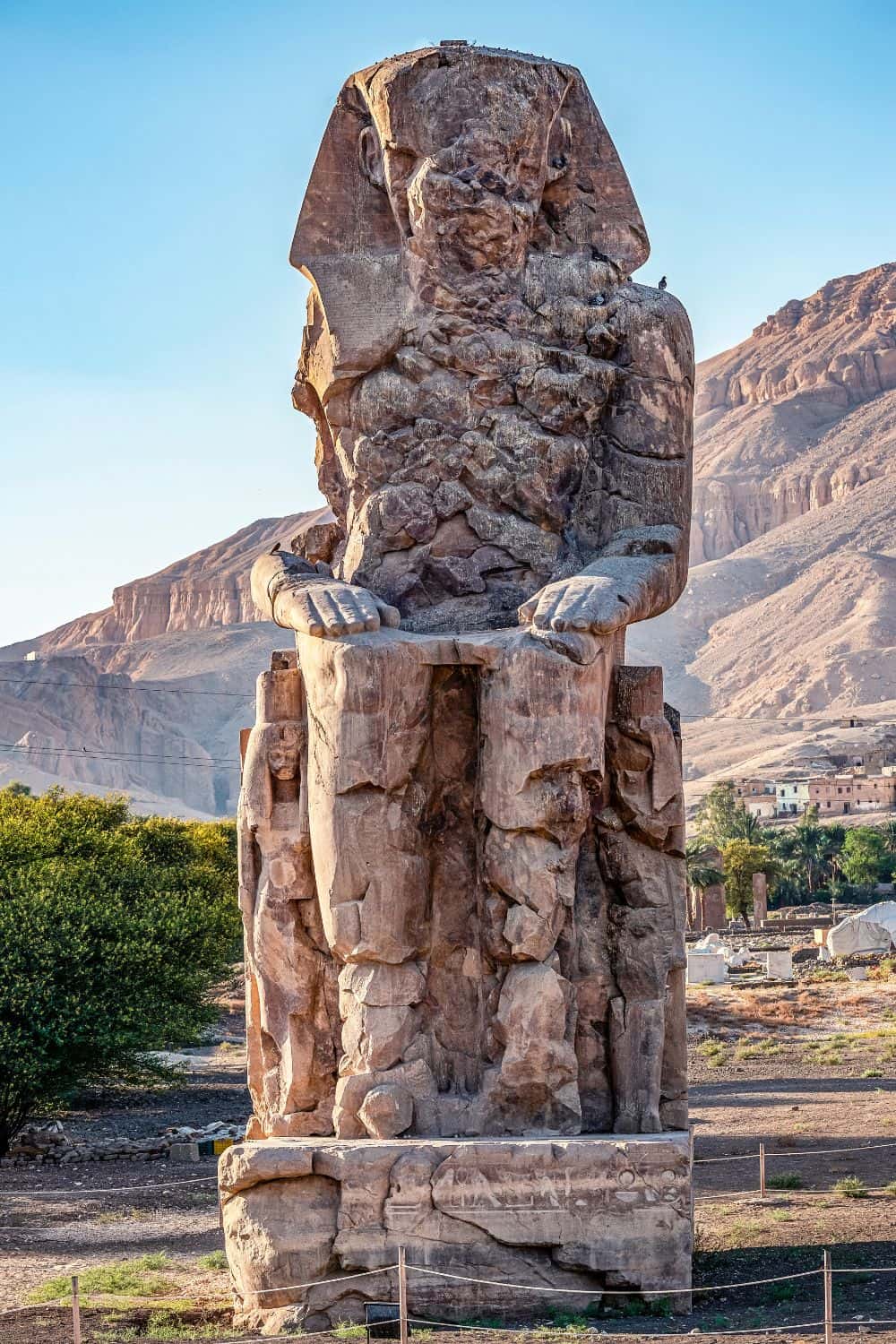
The Colossi of Memnon
- Carving the Colossi
Carving such massive monoliths required meticulous planning and precision.
Ancient Egyptian artisans, armed with copper chisels, saws, and abrasive sand, embarked on the monumental task of shaping the rough stone into detailed forms.
The process was a delicate balance between removing excess material and ensuring that the structural integrity of the statues remained intact.
- Transporting the Titans
One of the most awe-inspiring aspects of the Colossi’s creation is the transportation of these colossal statues from the quarries to their final resting place.
The journey covered a distance of several miles and required not only immense manpower but also ingenious engineering solutions.
Teams of laborers, sometimes numbering in the hundreds, used sleds to slide the massive stone blocks over specially prepared paths. To reduce friction and ease the movement, water was poured onto the sand in front of the sleds.
The sleds themselves were constructed with rollers and lubricated surfaces to facilitate the transportation process. The coordination required to maneuver these immense loads was a testament to the ancient Egyptians’ organizational skills and collective effort.
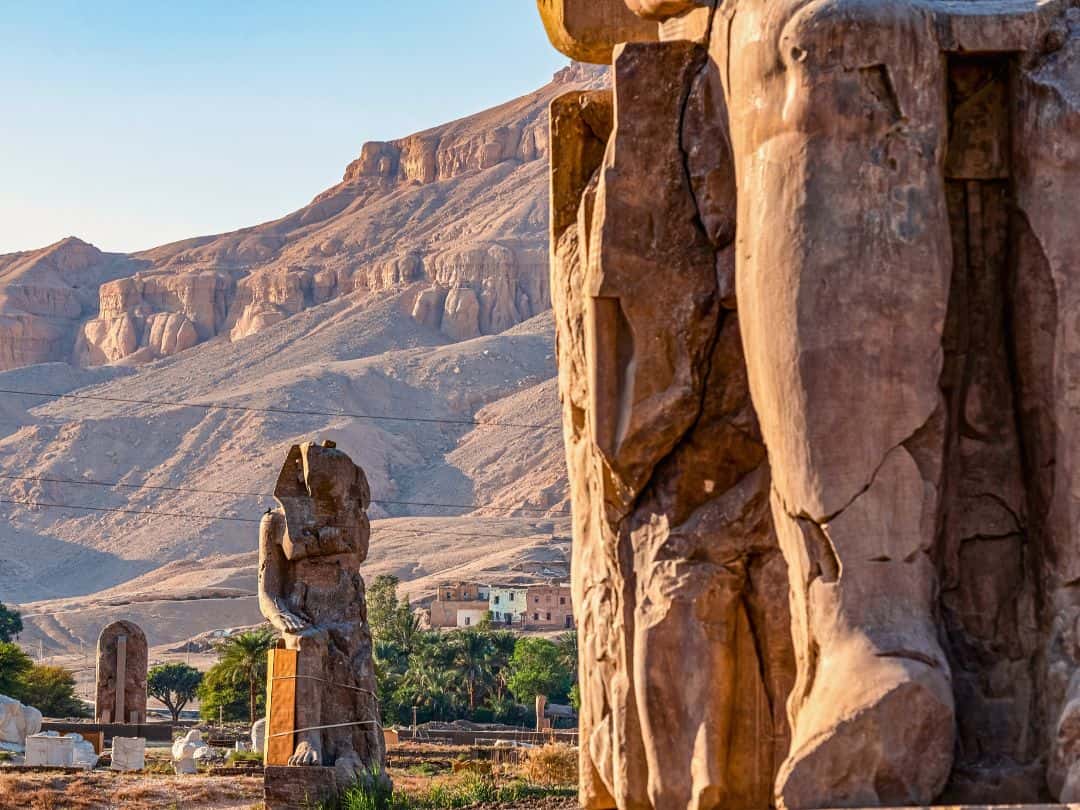
The Colossi of Memnon
- Setting the Scene
Upon reaching their destination, the statues were carefully positioned at the entrance of Pharaoh Amenhotep III’s grand mortuary temple on the west bank of the Nile.
These monolithic marvels, with their detailed craftsmanship and imposing presence, stood as a tribute not only to the pharaoh’s might but also to the innovation and mastery of ancient Egyptian stonecutters, engineers, and laborers.
- A Lasting Legacy
The Colossi’s creation left an indelible mark on the landscape of Luxor and the annals of history. Beyond their physical grandeur, these statues represent the ancient Egyptians’ intimate understanding of materials, engineering principles, and the synergy between art and science.
The engineering prowess displayed in the creation and transportation of these monolithic marvels serves as a beacon of human determination and innovation, a reminder that even the most colossal challenges can be overcome with vision, collaboration, and the indomitable spirit of human endeavor.
Guardians of Pharaoh's Legacy: Ancient Colossi of Memnon Significance
The Colossi of Memnon, with their towering presence and regal demeanor, held a profound role in the spiritual and cultural tapestry of ancient Egypt.
As guardians of Pharaoh Amenhotep III’s grand mortuary temple, these monumental statues bore the weight of immense symbolism, protecting the sanctity of the temple and embodying the pharaoh’s eternal connection to the divine.
- Sentinels of the Temple
Constructed during the 14th century BCE, the Colossi were strategically positioned at the entrance of Pharaoh Amenhotep III’s mortuary temple on the west bank of the Nile River.
This temple complex, dedicated to the god Amun, was designed not only as a site for the pharaoh’s posthumous veneration but also as a place where rituals and offerings could secure his place in the afterlife.
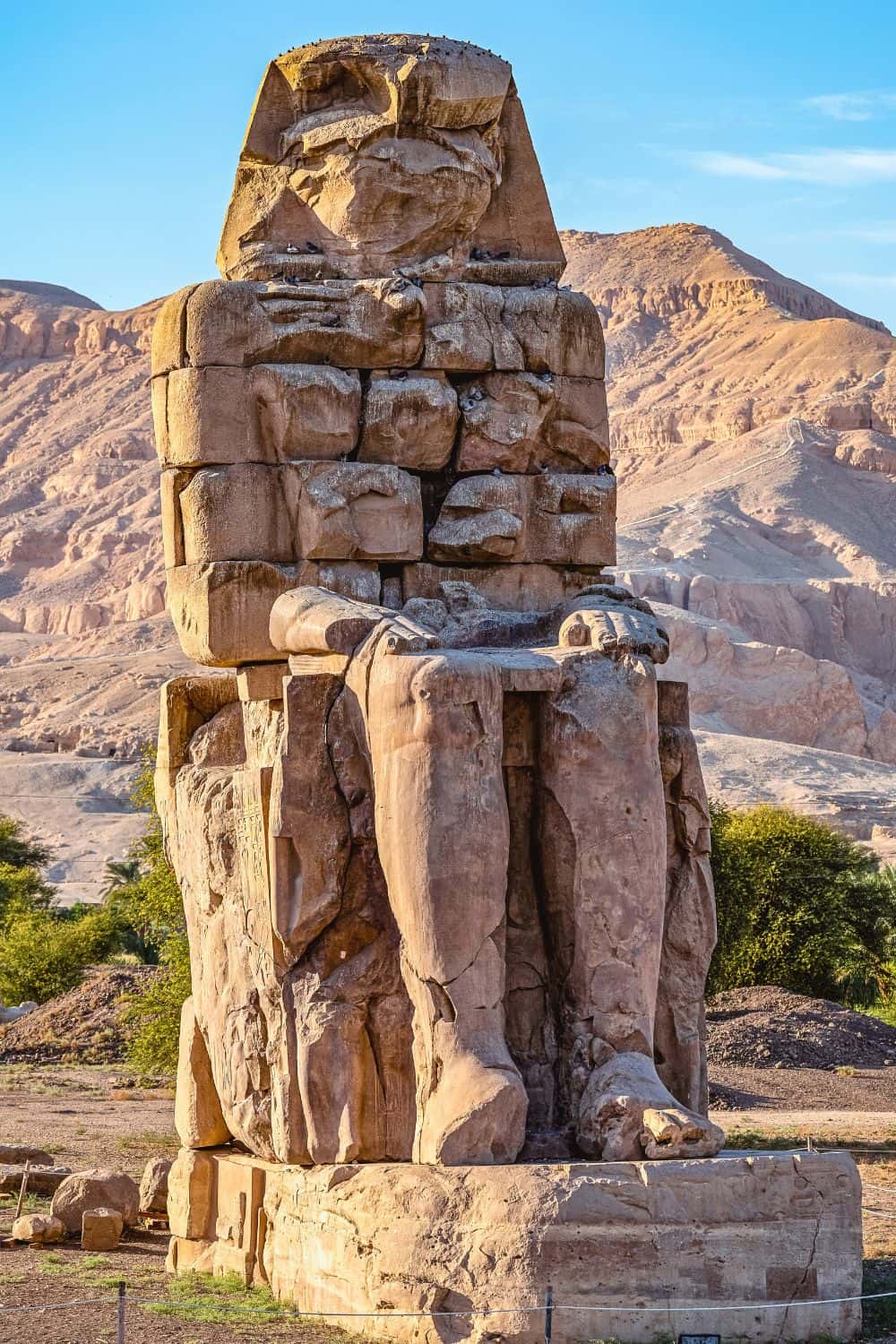
The Colossi of Memnon
- Divine Connection and Protection
The Colossi were not mere decorations; they were believed to embody the pharaoh’s divine essence and serve as conduits between the mortal realm and the realm of the gods.
In the eyes of the ancient Egyptians, these statues were physical manifestations of the pharaoh’s presence and authority, even beyond death. Their towering stature, ornate headdresses, and royal regalia conveyed the power and divinity of Amenhotep III.
- Rituals and Offerings
The temple complex, guarded by the Colossi, became a focal point for religious ceremonies and rituals. Priests and devoted worshippers offered prayers, incense, and other offerings to honor the pharaoh and beseech the gods for his continued well-being in the afterlife.
The Colossi, positioned at the threshold of this sacred space, served as intermediaries, conveying the prayers and supplications of the living to the divine realm.
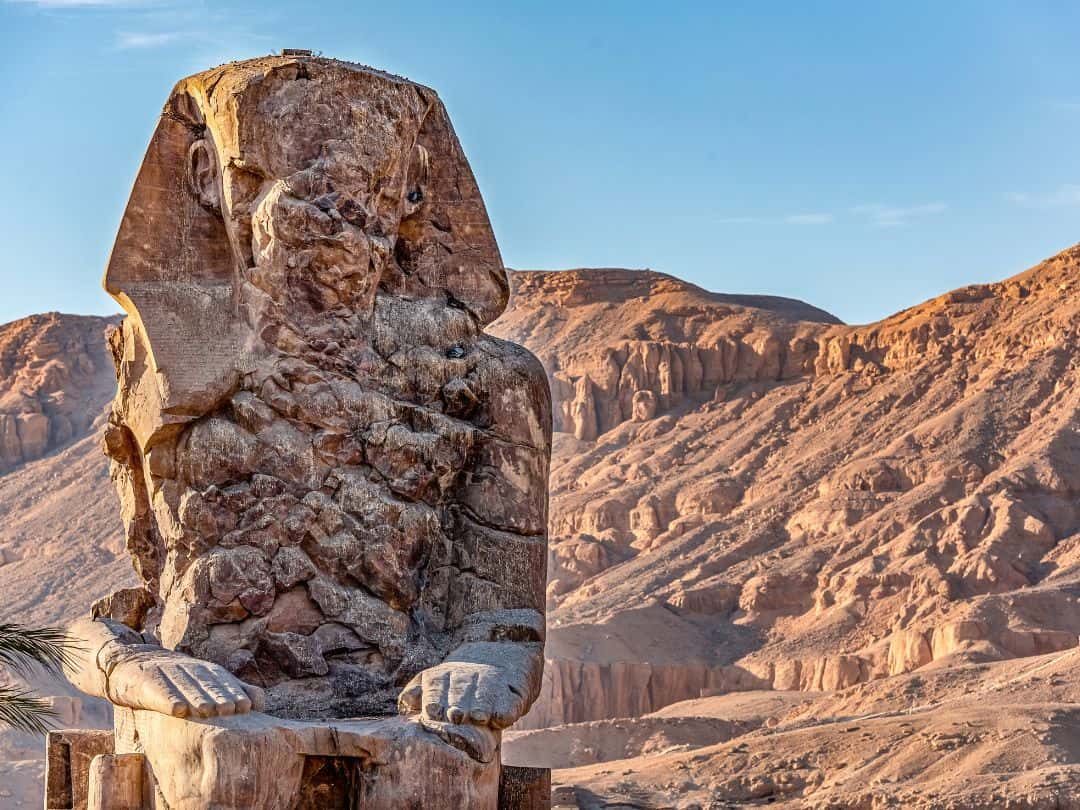
The Colossi of Memnon
- Eternal Presence
The significance of the Colossi extended beyond the realm of the living. In the ancient Egyptian belief system, the afterlife was a continuation of one’s earthly existence, and maintaining a connection to the physical world was vital.
The Colossi played a crucial role in this ideology, offering a tangible link between the pharaoh’s corporeal form and his enduring presence among the gods.
- Cultural Legacy
Beyond their religious importance, the Colossi of Memnon also reflected the socio-political and cultural dynamics of ancient Egypt.
They projected the power and grandeur of the pharaoh, serving as symbols of authority both within the kingdom and to foreign visitors.
These statues, now weathered by time and the elements, stand as silent witnesses to the rituals, beliefs, and aspirations of a society that sought to immortalize its pharaoh’s legacy.
The guardianship they provided to the mortuary temple underscores the deep reverence that the ancient Egyptians held for their rulers, and their imposing presence continues to inspire awe and contemplation in all who stand before them.
Architectural Symbolism: Colossi of Memnon Stone Messages
The Colossi of Memnon, with their imposing presence and meticulously crafted details, are not only artistic marvels but also vessels of profound symbolism that offer insights into the religious, cultural, and social beliefs of ancient Egypt.
Every aspect of their design, from the pharaoh’s pose to the hieroglyphics etched onto their surfaces, serves to convey power, divinity, and protection.
- Royal Pose and Attire
The statues depict Pharaoh Amenhotep III in a seated position, a pose that carries significant symbolism.
The seated pharaoh is a symbol of stability and authority, reinforcing the idea that the ruler’s reign is firmly established.
The pharaoh’s posture reflects his regal stature, with his hands resting on his knees. The royal attire, consisting of the kilt and the nemes headdress adorned with the cobra and vulture, further signifies his divine and kingly status.
- Hieroglyphic Inscriptions
The statues’ surfaces are adorned with intricate hieroglyphic inscriptions that celebrate the pharaoh’s accomplishments, invoke blessings, and offer prayers for his eternal well-being.
These inscriptions provide a window into the pharaoh’s reign, detailing his military victories, diplomatic achievements, and offerings made to the gods.
The hieroglyphics serve as both a historical record and a means of amplifying the pharaoh’s legacy.
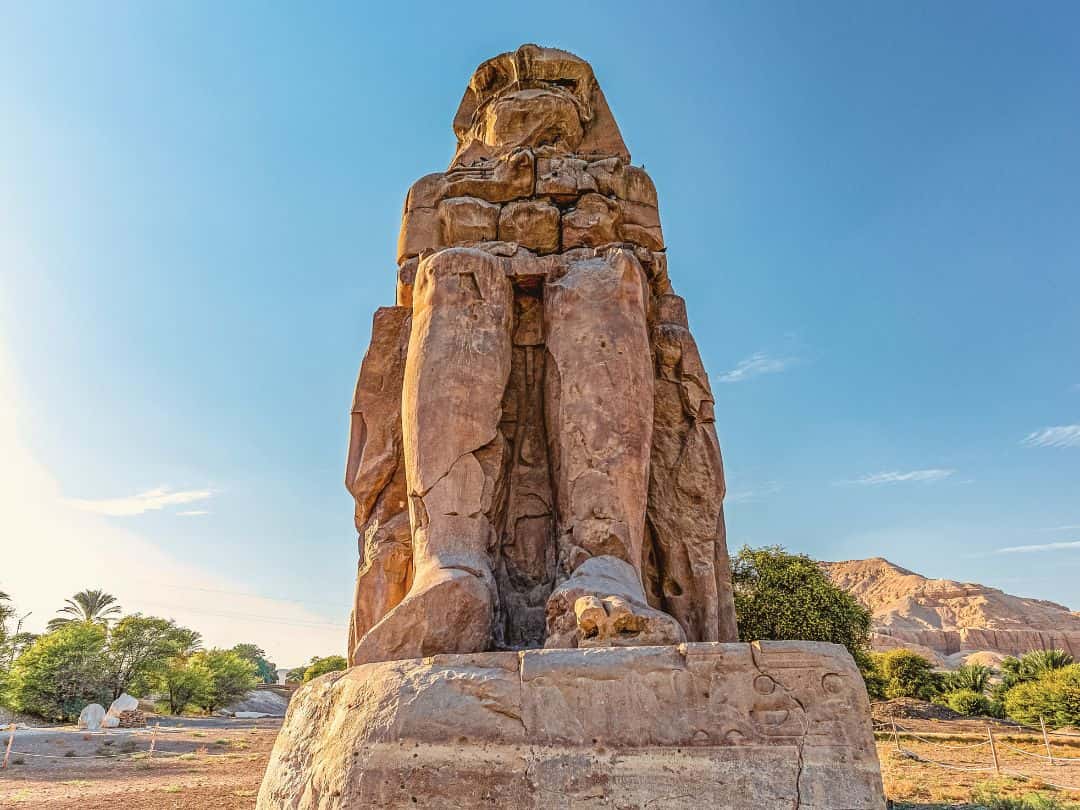
The Colossi of Memnon
- Divine Connection
Beyond their depiction of Amenhotep III, the Colossi are also associated with the gods themselves.
The nemes headdress, which features the uraeus (cobra) and the vulture, symbolizes the protection offered by the goddesses Wadjet and Nekhbet. This divine protection extended to the pharaoh as well as to the entire kingdom.
The statues thus stood as a physical manifestation of the pharaoh’s divine connection and his role as an intermediary between the gods and the people.
- Solar Symbolism
The pharaoh’s association with solar symbolism is evident in the Colossi’s design.
The solar disk atop the nemes headdress represents the sun god Ra, symbolizing the pharaoh’s divine lineage and connection to the sun deity. This connection conveyed the idea of the pharaoh as a conduit for cosmic energy and power.
- Protection and Guardianship
Positioned at the entrance of the mortuary temple, the Colossi served as guardians, protecting the sacred space from malevolent forces.
Their colossal presence, combined with their regal demeanor, projected an aura of authority and vigilance. It was believed that the pharaoh’s spirit would reside within these statues, offering protection not only to the temple but also to the kingdom itself.
Legacy of Amenhotep III: Vision in Stone
Pharaoh Amenhotep III, a towering figure in ancient Egyptian history, left an indelible mark on the landscape of both Luxor and the annals of time.
His reign, spanning from approximately 1386 to 1349 BCE, was characterized by political prowess, monumental construction, and cultural achievements that continue to captivate historians and enthusiasts alike.
- The Golden Age
Amenhotep III ascended to the throne during a time known as the Eighteenth Dynasty of the New Kingdom, often referred to as the “Golden Age” of ancient Egypt.
His father, Thutmose IV, had secured a stable kingdom, allowing Amenhotep III to focus on expanding and enhancing Egypt’s influence and grandeur.
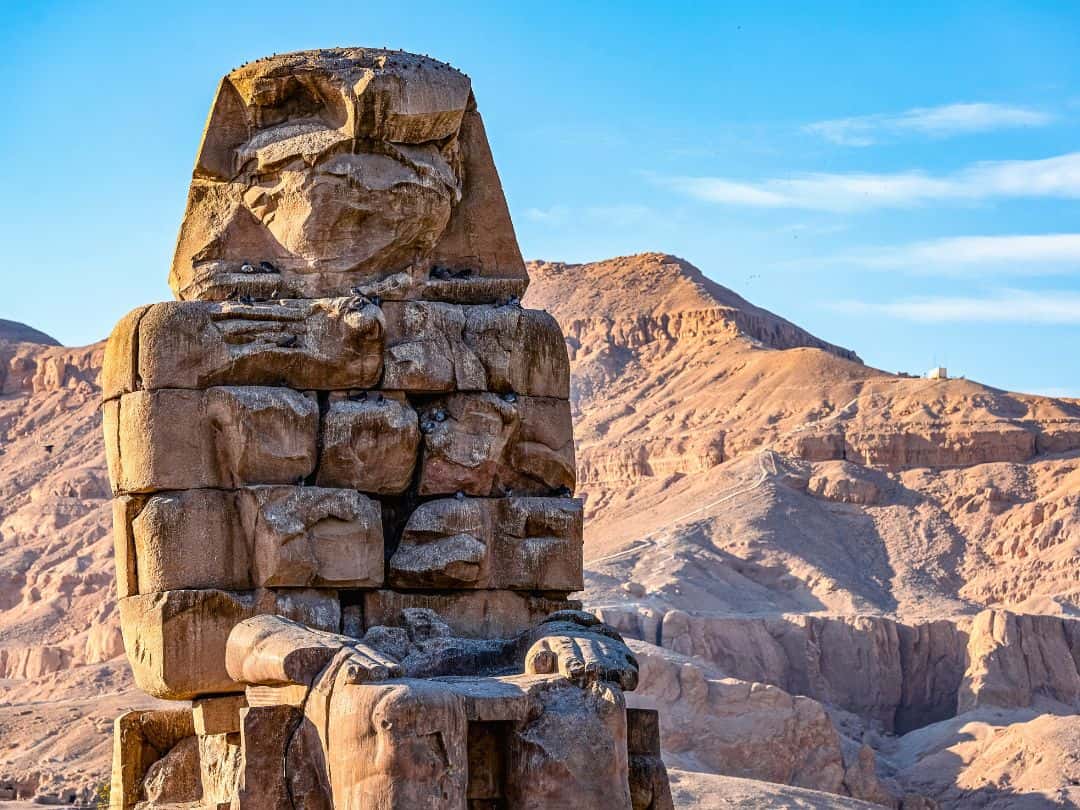
The Colossi of Memnon
- Architectural Ambition
One of Amenhotep III’s most enduring legacies is his ambitious architectural endeavors. The construction of the Colossi of Memnon was just one facet of his grand vision. He commissioned numerous other construction projects, including the massive mortuary temple on the west bank of the Nile, where the Colossi stood guard.
- International Relations
Amenhotep III skillfully navigated diplomatic relationships with neighboring kingdoms, forging alliances through marriage and negotiation. He conducted exchanges of gifts and correspondence with leaders from distant lands, creating an aura of prestige and international recognition for Egypt.
- Artistic Patronage
The pharaoh’s reign was also marked by a flourishing artistic and cultural scene. He supported and patronized artists, poets, and craftsmen, commissioning elaborate statues, monuments, and jewelry.
His court became a hub of creativity and innovation, fostering an atmosphere of cultural vibrancy.
Ancient Luxor's Cultural Hub: Heart of Civilization
In the heart of ancient Egypt, the city of Luxor—formerly Thebes—stood as a cultural and spiritual epicenter that left an indelible mark on history.
This thriving hub of civilization, nestled along the banks of the Nile River, was a bustling metropolis where art, religion, politics, and monumental construction converged, shaping the very essence of Egyptian identity.
- A Sanctuary of Spirituality
Luxor was more than a mere city; it was a sacred realm where the gods and the pharaohs intertwined. It housed some of Egypt’s most revered temples, including the monumental complex of Karnak, dedicated to the god Amun-Ra.
These temples were not only places of worship but also epicenters of ritualistic ceremonies, festivals, and processions that celebrated the divine connection between the mortal and immortal realms.
- The Avenue of Sphinxes
Connecting the temples of Karnak and Luxor was the iconic Avenue of Sphinxes, a pathway lined with hundreds of stone sphinxes that bore witness to royal processions and pilgrimages.
This grand avenue, flanked by awe-inspiring statues and adorned with symbolic carvings, led the way to Luxor Temple and formed a sacred corridor of spirituality.
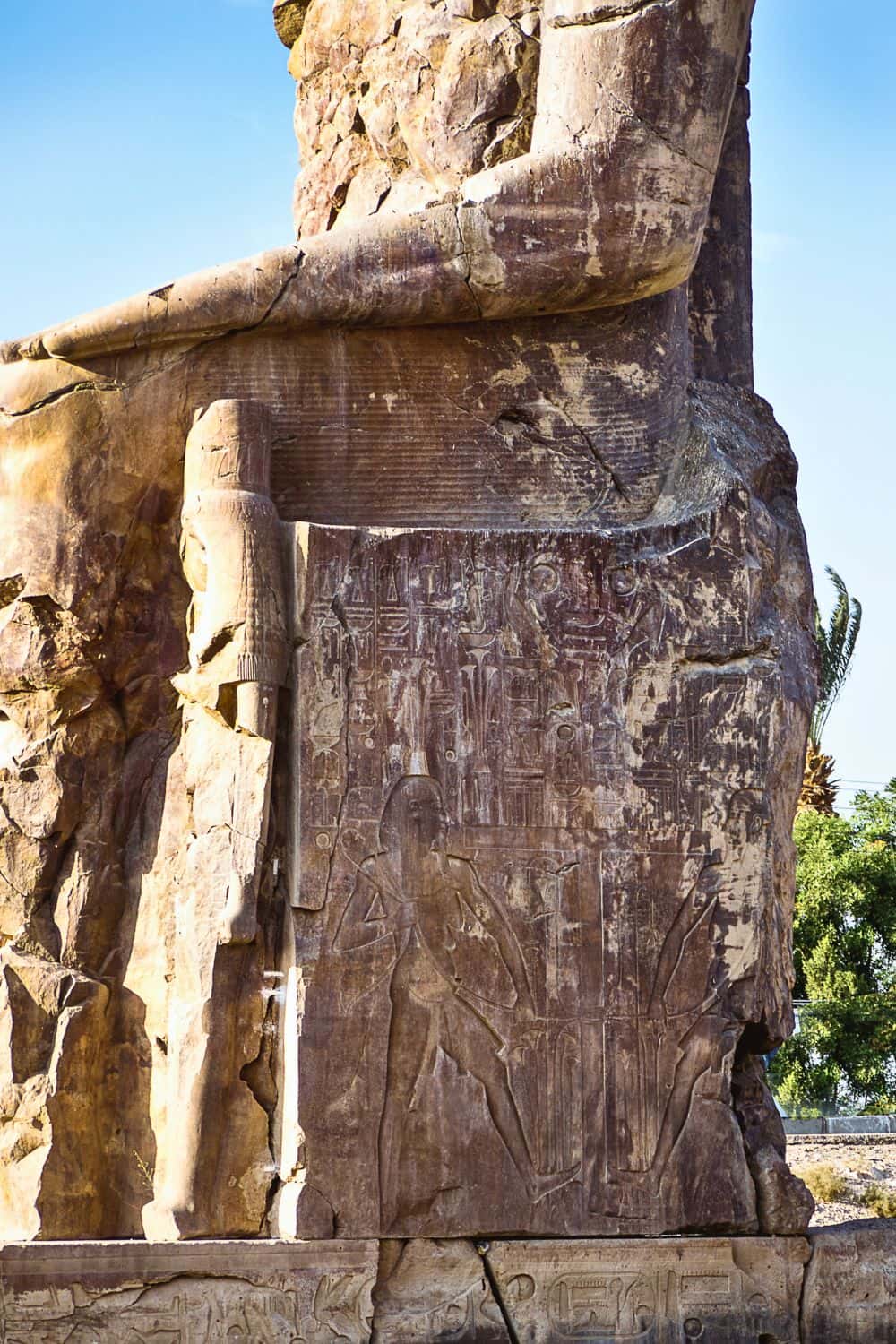
The Colossi of Memnon
- A Center of Craftsmanship
Luxor was a bustling hub of artistic and artisanal activity. Skilled craftsmen and artists congregated here to contribute to the construction and adornment of temples and monuments.
The city’s workshops produced intricate jewelry, pottery, sculptures, and textiles that adorned both royal courts and humble households.
- The Grand Mortuary Temples
The city’s landscape was dominated by grand mortuary temples, such as the one guarded by the Colossi of Memnon. These temples were not merely monuments to the pharaohs but were dedicated to rituals, offerings, and commemoration of the kings’ legacies.
The Colossi, standing at the entrance of these temples, served as sentinels, welcoming pilgrims and emphasizing the significance of the sacred space beyond.
Preserving Colossi of Memnon: Timeless Legacy Safeguarded
As the sands of time continue to sweep through the millennia, modern preservation efforts have arisen to protect and conserve the monumental Colossi of Memnon.
These towering sentinels of ancient Egypt, battered by natural forces and human interaction, require meticulous care to ensure their structural integrity and cultural significance endure for generations to come.
- Scientific Analysis
Modern preservation efforts begin with thorough scientific analysis. Teams of archaeologists, engineers, and conservators conduct detailed assessments of the statues’ condition.
Advanced techniques such as 3D scanning, laser imaging, and geophysical surveys are employed to understand the extent of weathering, erosion, and structural vulnerabilities.
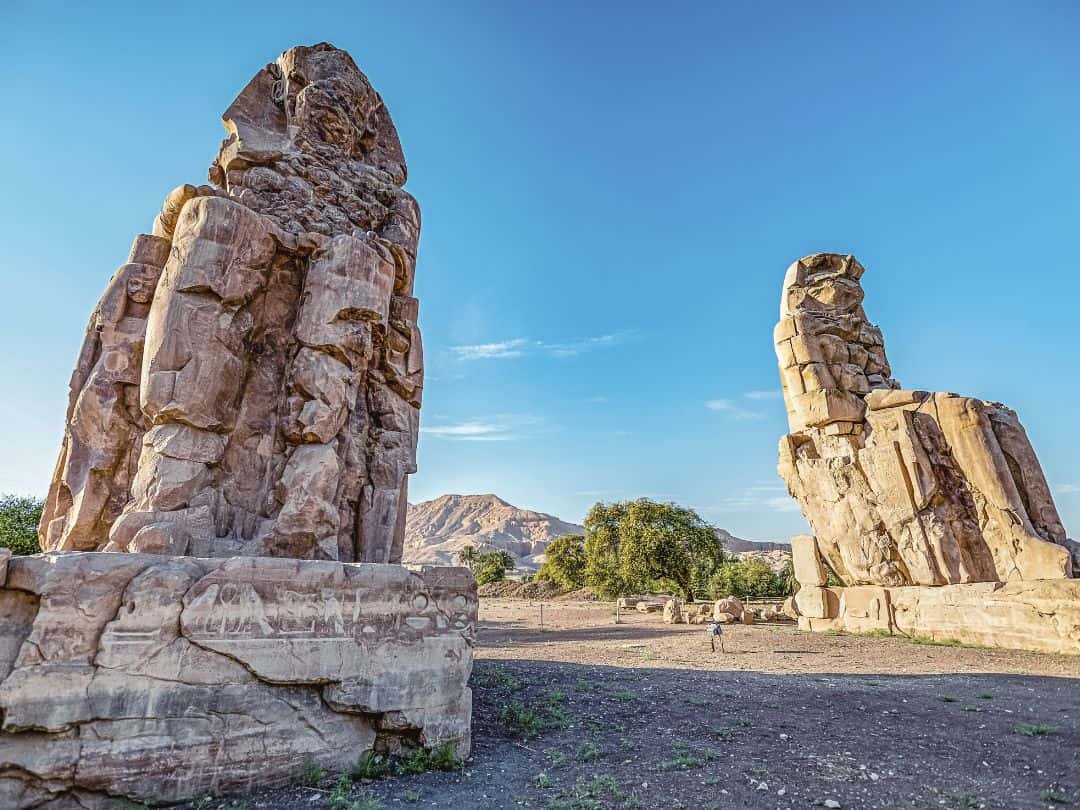
The Colossi of Memnon
- Conservation Techniques
To counteract the wear and tear of time, specialists employ various conservation techniques. Weathered surfaces are cleaned using non-invasive methods to remove debris and encrustations while preserving the original patina. Damaged sections are meticulously repaired using compatible materials that match the stone’s composition and color.
- Structural Support
As ancient monuments are exposed to environmental stressors, including temperature fluctuations and seismic activity, it’s imperative to ensure their stability.
Reinforcement methods, such as grouting cracks and installing support structures, help maintain the statues’ structural integrity without compromising their authenticity.
You Might Also Like
12 Important TIPS for First VISIT to VALLEY of the KINGS in Luxor
12 Important TIPS for Hot AIR BALLOON RIDE in LUXOR, Egypt (Read Before You Book It)
Perfect 2-Day Itinerary in Luxor (7 Things You Can’t Miss)
14 EGYPT TIPS for FIRST TIMERS (How to Save Time, Money, and Be Safe)
How to Visit And What to See at ABU SIMBEL (9 Practical Things to Know)
How to Visit KARNAK TEMPLE in Luxor (9 Amazing Things You Can’t Miss)
Now, It Is Your Turn, I Would Like to Hear Back from You!
Are you planning your trip to Luxor?
Please let me know! Drop me a quick comment right below!
Click on any of the images below to get inspired and to help you with the planning process for your trip to Luxor!
